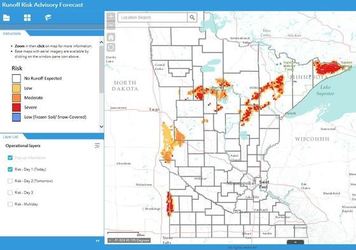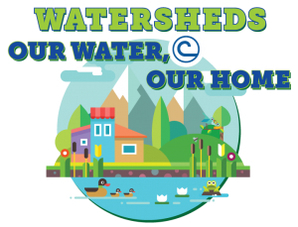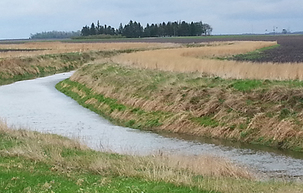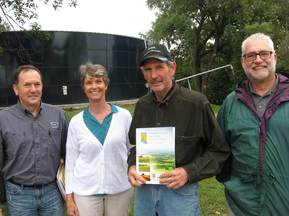 The Minnesota Department of Agriculture (MDA) has teamed up with
the National Weather Service to design a tool that helps farmers and commercial
applicators determine the best time to apply manure.
The Runoff Risk
Advisory Forecast tool uses past and predicted National Weather
Service weather data like precipitation, temperature, and snow melt. It
predicts the likelihood that applied manure will run off fields in daily, next
day, and 72 hour increments. Farmers and commercial applicators use an
interactive map to locate their field and find the forecasted risk. Users can
also sign up for email
or text messages for their county that alert them to a severe runoff
risk for that day. Full news release.
The Runoff Risk Advisory Forecast is the first active
tab. There are four levels of risk (No Runoff Expected, Low, Moderate and
Severe) that could be shown on the map. When
the risk is Moderate or Severe, it is recommended that the applicator evaluate
the situation to determine if there are other locations or later dates when the
application could take place. You can select to see risk for Day 1
(default shown), Day 2 (Tomorrow), Day 3 or Multiday (72 hours).
The
forecasting tool can also be used by others looking for climate information
including 2” soil depth temperatures which are useful at planting time, 6” soil
depth temperatures which are helpful when determining fall fertilizer
application in appropriate areas and daily precipitation forecasts. These can
be found on the tabs at the top of the website.
Back to top
|
 The National Association of Conservation
Districts (NACD) designates April 29-May 6 as Soil and Water Stewardship Week. In its 63rd year, it promotes resource conservation across the country. This year the theme is “Watersheds: Our Water, Our Home” and highlights the importance of caring for one of the most critical resources in the world, water. Gov. Mark Dayton has made the protection of Minnesota’s water quality a top priority of his administration.
Each year more than 3,000
conservation districts nationwide participate in the event, making Stewardship Week one of
the largest national conservation programs in the world. NACD relies on each local conservation district to encourage stewardship through educational programs, field days and workshops. In Minnesota there are 89 soil and water
conservation districts working in both urban and rural settings.
“Soil and Water Conservation Districts are
locally led and the staff that lead each district are knowledgeable about
resource issues within their communities,” says LeAnn Buck, Minnesota
Association of Soil and Water Conservation Districts Executive Director. “They
focus on providing soil and water conservation services to private landowners,
which is essential because seventy-eight percent of Minnesota’s lands are
private."
Back to top
|
U of M Extension offers two new soil health blog posts: "What is your definition for soil health?" and "Effects of liquid manure injection into a winter rye cover crop: on-farm trials." Each month will include a new article with the purpose of defining the current state of the science related to manure and soil health. A team of university and NRCS professionals from the North Central region are initiating several educational activities addressing soil health topics including this blog .
What is your definition for soil health? - Christina Curell, Michigan State University:
Over the past several years, state and federal agencies and researchers have been trying to come up with a definition for soil health. The NRCS defines soil health as "the continued capacity of soil to function as a vital living ecosystem that sustains plants, animals, and humans." Another definition embraced by many is the improved function in terms of crop yield response to inputs, such as fertilizer efficiency. Continue Reading...
Effects of liquid manure injection into a winter rye cover crop: on-farm trials - Les Everett, University of Minnesota Water Resources Center and Randy Pepin, U of M Extension:
Nitrate levels above the drinking water standard of 10 ppm are frequently found in subsurface drainage tile water or groundwater below farm fields of the upper Midwest. Nitrogen comes from applied manure and fertilizer, along with natural mineralization of organic matter. Continue reading
Back to top
The Dept. of Agriculture's proposed Groundwater Protection Rule was published in the State Register April 30 launching an 80-day public comment period. The goal of the rule is to work with local
farmers to reduce elevated nitrate levels in groundwater and ensure Minnesota
residents have clean, safe, and reliable drinking water supplies.
Nitrate is
one of the most common contaminants in Minnesota's groundwater; elevated nitrate
levels in drinking water can pose serious health concerns for humans. The
proposed rule, which is based on the input of the farmers and landowners who
the rule would apply to, would regulate the use of nitrogen fertilizer in areas
of the state where soils are prone to leaching and where drinking water
supplies are threatened.
Starting April 30 public comments on the rule can be made on the Office of Administrative Hearings website at www.mn.gov/oah. The rule is part of the state’s overall
Nitrogen Fertilizer Management Plan developed with broad
stakeholder input over five years and implemented in 2015. More
information on the rule and the NFMP is available at www.mda.state.mn.us/nfr.
Back to top
The
Minnesota Dept. of Agriculture has been developing a Minnesota Water
Research Digital Library (MNWRL). The library was recently enhanced, and
at the same time doubled in size to now include over 2,600 peer-reviewed and
non-peer-reviewed articles and reports (including “grey” literature that can be
hard to find). The new version of the library just went online and seems
rather user-friendly (but may still need further testing). Check it out at: www.mn.gov/wrl. The lead person at MDA for this project is Steve Roos (Agricultural Marketing and Development
Division 651-201-6631, stephan.roos@state.mn.us).
Back to top

Buffer strips are the top
water-quality improvement strategy in the South Fork Crow River watershed,
according to new draft reports released April 17 by Minnesota Pollution Control
Agency (MPCA). The agency and local partners are seeking public comments
through May 16 about the buffer strip implementation efforts and other
protection and restoration strategies.
The Total Maximum Daily Load report establishes the amount of each pollutant
that a water body can accept and still meet water quality standards. It
identifies 42 stream segments failing to meet water quality standards due to
low dissolved oxygen, high phosphorus levels, and altered hydrology. The report
also shows that field drainage and tile drainage to waterways, especially
Buffalo Creek and the South Fork Crow River, are important factors in stream
impairments.
The Watershed Restoration and Protection Strategy summarizes past efforts to
monitor and improve water quality, and identifies future strategies for
restoring and protecting the watershed’s water quality. The WRAPS report
identifies areas along Silver Creek and the South Fork Crow River, upstream of
Hutchinson, where healthy buffer strips are helping to improve water quality.
Other suggested strategies include increasing water storage, proper culvert and
bridge sizing, adding riparian buffers with deep roots, and restoring
connectivity and natural stream channels.
The South Fork Crow River
watershed is located in south-central Minnesota and encompasses parts of
Kandiyohi, Renville, Meeker, McLeod, Sibley, Wright, Carver, and Hennepin
counties. The South Fork Crow River joins with the North Fork Crow at Rockford
and then joins the Mississippi River near Dayton.
The reports are available at: www.pca.state.mn.us/water/watersheds/south-fork-crow-river,
or at the MPCA’s St. Paul office, at 520 Lafayette Road North. The MPCA
encourages those interested in the South Fork Crow River Watershed to review
and provide feedback on the reports. Comments may be submitted to Scott Lucas,
MPCA, 7678 College Road, Baxter, MN, 56425, or by e-mail to, scott.lucas@state.mn.us
by 4:30 p.m. on May 16, 2018. For more information, contact Scott at
218-316-3874, or toll-free at 800-657-3864.
Written comments must indicate
whether they pertain to the South Fork Crow River watershed’s TMDL or WRAPS
report. They should clearly state the action you wish the MPCA to take,
including references to sections of the report that you believe should be
changed; please provide specific reasons supporting your position. More information is available on
the MPCA’s watershed web pages.
Back to top
|

Marcie Weinandt retired May 1
from the Dept. of Agriculture after working more than 30 years on
rural development, agriculture and water resources, impacting local to national
policy with partners in non-profits, educational institutions and local, state,
tribal and national governments.
In the last five years she worked
on the development and implementation of the Minnesota Agricultural Water
Quality Certification Program. Photo: Water quality certification award at a Stearns County dairy farm, (L-R): Mark Lefebvre, Marcie Weinandt, Dean Klaverkamp, Dennis Fuchs.
"It's been a great run. I've had some fabulous
opportunities in diverse rural and water quality areas," Marcie
says. Working with county SWCDs, the Water Quality Certification Program
has been growing steadily, now with more than 1,044 new conservation practices
across 354,492 acres on 555 farms. Two recent staff hires will continue to
work with program director Brad Redlin. "It's all in good
hands," she says.
Prior to MDA Marcie was CEO of the Midwest Assistance
Program, a nine-state organization providing water and waste water technical
assistance to small rural communities, policy director for the Rural Policy
Research Institute in Washington DC, Minnesota Rural Partners Director,
Renville County Commissioner and serving on the Citizens’ Advisory Committee
for the Minnesota River. "I started my career writing the first Local
Comprehensive Water Plans for six southwestern counties in 1988," she says.
Now with more time Marcie plans to visit out-of-state
grandchildren more often, and volunteer with political campaigns. Living in
Mounds View she will continue on the citizens advisory committee for the Rice
Creek Watershed.
Back to top
|
ISG announces a workshop June 27 in Mankato on agricultural drainage and future of water quality. Check-in at the Verizon Center opens at 8 a.m. and the workshop runs from 9 a.m. to 3:15 p.m. The registration fee is $30 and space is limited; register online. For more information, contact ISG's Principal + Agricultural Drainage leader: Chuck Brandel PE, chuck.brandel@is-grp.com.
Back to top
Establishing cover crops in corn and soybeans is not without its challenges in Minnesota. There is little growing season left after harvest and soil moisture and herbicide carryover can often limit the ability to get a good cover crop stand when interseeding mid-season. Wheat, barley, and oats make establishing cover crops much easier. Small grains also provide the opportunity to interseed cover crops. After all, interseeding alfalfa with oats is a common method to establish alfalfa. This approach can easily be extended to other legumes, including clovers and even grasses like annual ryegrass. Read more. - Minnesota Extension Crop News, 4/13/18.
Back to top
The Minnesota Pollution Control Agency (MPCA) is considering an update to its
water fees and has created the Water Fee Advisory Committee to provide input to
the Commissioner on this important topic. The next Water Fee Advisory Committee
meeting will be held on May 4, 2018, from 9:00 - 12:00 at the MPCA St. Paul
office Board Room and via WebEx. The Advisory Committee meetings are open to
the public.
The MPCA will provide more information about this meeting and how to access
the meeting via WebEx closer to the date. Please visit the Water
Quality Fee Rule webpage for updates. The webpage also contains information
about the water fees.
Please forward this announcement to other interested parties that you know.
They can sign up to receive these notices about the Water Quality Fee Rule at subscribe
here.
Back to top
The Minnesota Board of Animal Health urges horse owners to do their part to stop the spread of a highly contagious horse disease after it has been confirmed in neighboring states. North and South Dakota recently confirmed cases of Equine Herpesvirus Myeloencephalopathy (EHM), a potentially fatal and reportable disease. The last case of EHM diagnosed in Minnesota was in 2015. The Board has an official control plan for EHM, and if a Minnesota
horse is confirmed to be EHM positive or has been determined to be exposed to
the disease, it must be quarantined. The Board then works with herd
veterinarians and horse owners to carry out testing and observation protocols
defined in the control plan before the quarantines can be released. Read full BAH news release.
Back to top
SWCS Conservation News Briefs
4/12/18
Carrot vs. stick: How should Minnesota get to cleaner
water?
MPR, 4/16/18
What is sustainability? It depends on who you ask
AgWeek, 4/16/18
Back to top
June 6-8: World Pork Expo, Des Moines.
June 19-21: Agro-forestry Institute, SWROC, Lamberton.
June 27: Ag drainage and water quality workshop, Verizon Center, Mankato.
July 10: Summer Beef Tour, Cottonwood County
fairgrounds, Windom.
Back
to top
The
MPCA Agriculture Stewardship-Land, Water, Livestock newsletter welcomes news from partners about, projects, people, and
upcoming events. Email submissions to forrest.peterson@state.mn.us.
Past issues of Feedlot Update are available on the feedlot program publications webpage.
|